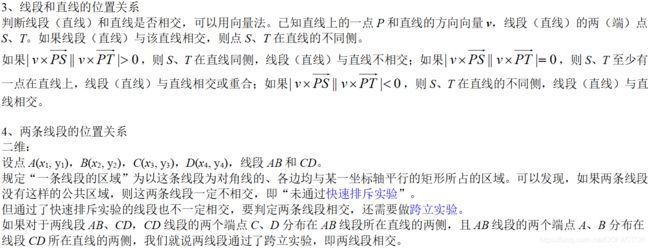【代码超详解】ZOJ 2551 / POJ 2653 Pick-up Sticks(快速排斥实验 + 跨立实验判断线段是否相交 · 模板)
一、传送门
http://poj.org/problem?id=2653
https://zoj.pintia.cn/problem-sets/91827364500/problems/91827366050
二、算法分析说明与代码编写指导
overlapped 函数:
返回两个区间是否重叠。若不交,返回-1;只重叠与一点(左端区间的右端点与右端区间的左端点重合),返回0;有重叠,返回1。
cross_product:返回两个二维向量的向量积。二维向量的向量积一般定义成标量:
![]()
intersected 函数用快速排斥实验和跨立实验判断两条线段是否相交:
 题意:依次往地上扔棍子,问哪些棍子在棍子堆的最顶上。
题意:依次往地上扔棍子,问哪些棍子在棍子堆的最顶上。
考察任意两根木棍是否有交点即可。
本题中,无论是否将其中一条线段的交点为端点的情况包括在相交的范畴,都不影响 AC。
但是要注意,外层循环变量是递减的,也就是说先考察后面扔到地上的木棍再考察前面的。原因是:每根木棍只会被后面扔在它上面的木棍压住。如果两层循环的循环变量都是递增的,那么之前判定没有与其它木棍相交的木棍一旦被后来的木棍压住,就无法修正判定结果,导致 WA。当然,由于本题数据量较大,这种出错情况会导致输出的在顶上的木棍数量非常多,从而 TLE。
三、AC 代码
POJ 2653:
#includeZOJ 2551:
#include